The Magnitude of 100-Foot Waves: Nature's Power Unleashed
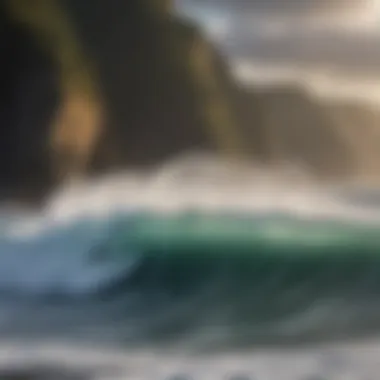
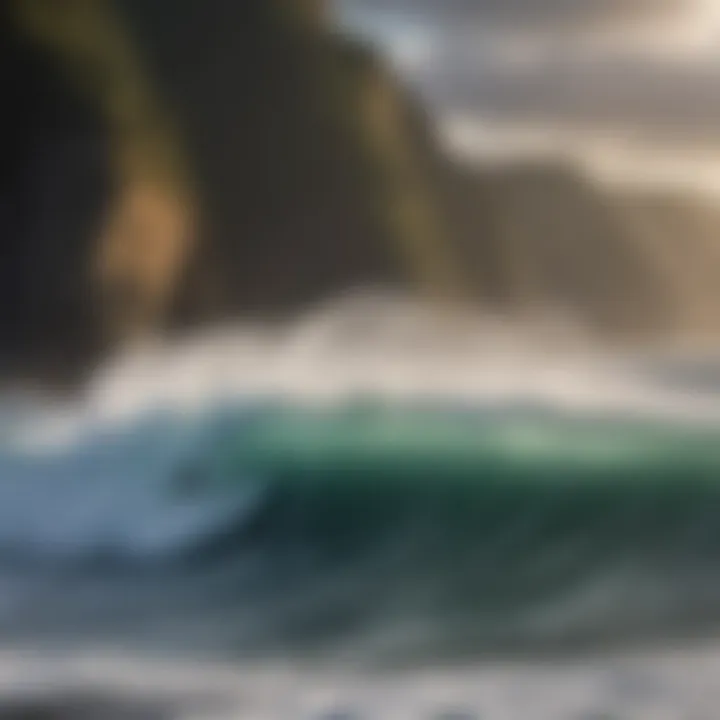
Intro
The ocean can be a rough playground, respecting no boundaries and defying human control. Among its varied moods, the existence of 100-foot waves captures both awe and dread. These towering walls of water, often depicted in dramatic imagery, embody nature's raw and formidable strength. But what causes such waves to form? And how do they affect our coastal communities and surfing culture? In this article, we will delve into the underlying science of massive waves, their occasional beauty, and the inherent dangers they incur.
Understanding these colossal waves means unraveling a complex web of environmental factors, oceanic dynamics, and human interaction. Surfers yearning to ride these gigantic swells must grapple with countless challenges, while researchers work tirelessly to decode the patterns surrounding them.
As we embark on this exploration, we’ll look at how nature orchestrates these phenomenon, and also touch upon the cultural significance they hold for adventurers and surfing history. Get ready to dive deep into a subject that harmonizes elements of science, adventure, and a deep respect for the ocean.
Gear Recommendations
When it comes to tackling 100-foot waves, having the right gear is crucial. The difference between a successful ride and a harrowing wipeout often lies in the equipment you choose.
Essential Gear for Beginners
For those just starting to flirt with the idea of riding massive waves, here’s what you ought to have:
- Wetsuit: A thick wetsuit keeps you warm in cold waters and provides some buoyancy. A 4/3mm or 5/4mm suit is advisable for chillier conditions.
- Surfboard: A big wave gun is necessary. These boards are typically longer and narrower, designed for speed and stability. Choose one that's specifically made for larger swells.
- Leash: A reliable leash connects you to your board, ensuring it doesn’t drift away after a fall.
- Impact Vest: This adds an extra layer of buoyancy and protects against hard hits.
Advanced Equipment for Professionals
Once you’ve honed your skills and are ready for the real deal, consider investing in higher-end gear:
- Tailored Big Wave Board: A custom board can give you an edge. Work with experienced shapers who understand the nuances of big wave surfing.
- Fins: High-performance fins that adapt to wave dynamics can enhance your control in massive swells.
- Inflatable Vest: A safety feature that can inflate in dangerous situations. Important for those venturing into serious conditions.
- Satellite Communication Device: Useful for keeping in touch with your crew during remote surfing sessions.
Techniques and Tips
Riding the monster waves is not just about fancy gear; it’s about mastering techniques that can ensure safety and success.
Skill Improvement Strategies
- Read the Ocean: Understanding wave patterns, currents, and winds will empower you to make informed decisions. Know where those waves will break.
- Practice Paddle Strength: Building your endurance through paddling will enable you to catch those quick waves that others might miss.
- Observation & Learning: Watch the pros. There’s much to learn from observing how experienced surfers tackle massive swells.
Safety Practices and Guidelines
- Never Surf Alone: Always have a buddy. In case of trouble, having a partner can save lives.
- Know When to Say No: Size and conditions can wildly vary. Be honest with yourself about your abilities.
- Emergency Training: Make sure you are trained in rescue techniques and know basic first aid. Preparation could be the difference between life and death.
Safety is paramount. Your equipment and skills matter, but an informed mind keeps you alive.
Preamble to Ocean Waves
Ocean waves are a fascinating spectacle of nature, representing both beauty and raw power. They play a critical role in the dynamics of our planet, affecting everything from coastal erosion to the behavior of marine life. Understanding waves, particularly the formidable 100-foot giants, is crucial not just for the scientific community, but also for surfers, environmentalists, and coastal residents. Waves serve as a bridge between the land and sea, and their influence extends far beyond our immediate view.
When discussing the phenomenon of 100-foot waves, it is essential to start with a foundational grasp of what ocean waves are, and how they behave under various conditions. This section will lay the groundwork for the interplay of factors that contribute to such extraordinary wave formation.
Defining Ocean Waves
Ocean waves are essentially energy traveling through water, caused by a variety of factors, predominantly wind. To break it down, think of waves as up-and-down motions of the sea surface, resembling rolling hills that can vary greatly in size. They are often defined by their height, length, and speed, which can shift dramatically based on the environment and atmospheric conditions.
This energy can manifest in different ways, leading to a variety of wave types, each characterized by distinct attributes. Even slight variations can change how these waves interact with the shoreline and with one another, underscoring the dynamic nature of ocean hydrodynamics.
Classification of Waves
Waves can be classified in multiple ways, but for our context, we will look closely at three primary categories: wind-driven waves, seismic waves, and tsunamis. Each of these types of waves has unique characteristics and influences that shape the coastlines and experiences of those who surf or live near the ocean.
Wind-driven Waves
Wind-driven waves are the most common type that surfers encounter every day at the beach. They occur when the wind blows across the surface of the ocean, transferring energy to the water. The intensity of the wind, its duration, and the distance it travels over open water—the fetch—each play a role in determining the wave's size and strength.
A key characteristic of wind-driven waves is that they can build considerable height over time, especially during stormy conditions. This is crucial for understanding the formation of giant waves like those that reach 100 feet. The comparison here is like blowing into a bowl of water; if you keep blowing, the ripples become larger and larger.
However, relatively calm winds can produce smaller waves, which might not have the same thrill factor. The advantage of wind-driven waves is their predictability; surfers can often find reports detailing wave conditions that can lead to excellent riding opportunities.
Seismic Waves
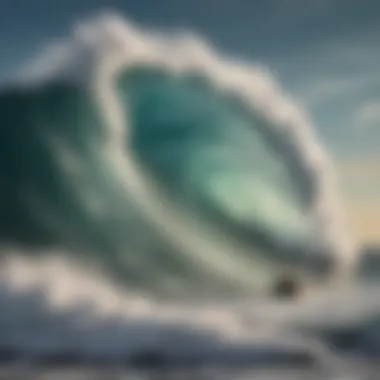
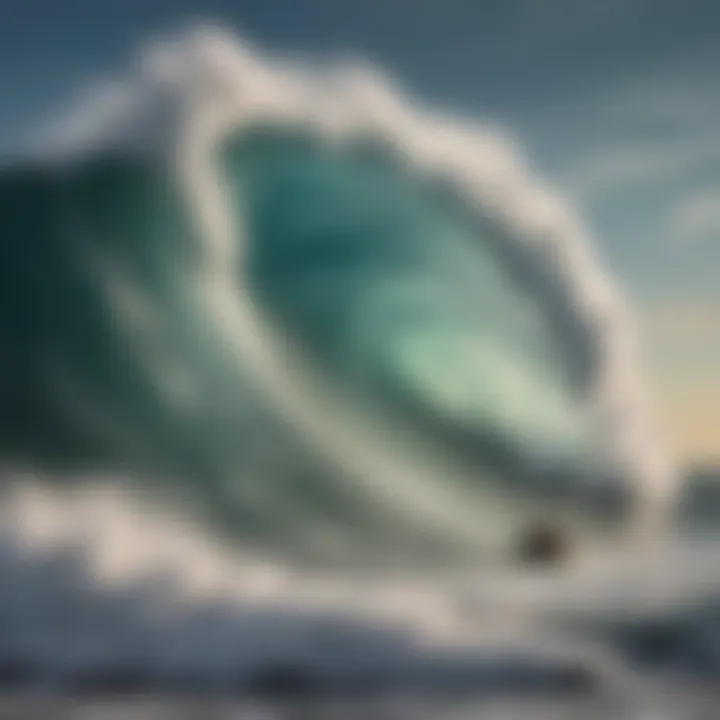
Seismic waves primarily arose due to tectonic activity beneath the ocean floor, commonly linked to earthquakes. When tectonic plates shift, they can generate an enormous amount of energy that displaces water suddenly, creating waves of varying heights. These seismic waves can be substantial, significantly impacting coastal areas often far from the epicenter of the seismic event.
Their unique feature lies in their potential for destruction, especially when they lead to what we commonly refer to as tsunamis. They serve as a reminder of the ocean's unpredictable nature and the forces at play. The advantage of recognizing seismic waves is that they can alert coastal communities to impending threats, prompting timely evacuations and safety measures.
Tsunamis
Tsunamis are perhaps the most terrifying examples of wave phenomena, striking fear into the hearts of coastal inhabitants. Unlike normal ocean waves, tsunamis can span entire ocean basins and can reach enormous heights when they make landfall. They are caused, as mentioned, primarily by large underwater disturbances such as earthquakes or volcanic eruptions.
Their key characteristic is their ability to travel at incredibly high speeds across deep water, often unnoticed until they reach shallower regions, where their energy compresses and the waves grow taller. One unique feature of tsunamis is that they don't always appear as massive waves until it’s too late—the height can range from non-threatening to towering, depending on various factors.
While they are not beneficial in any sense, understanding tsunamis is crucial for ensuring preparedness against their devastating impacts. Coastal communities can benefit from investment in early warning systems and tsunami education, ultimately mitigating the dangers associated with these monumental waves.
The Emergence of 100-Foot Waves
The allure of 100-foot waves holds a strong fascination for surfers and ocean enthusiasts alike. Understanding their emergence helps one appreciate not only their raw power but also the intricate elements that interplay to create such colossal waves. Waves of this magnitude do not just materialize without reason; they are the result of numerous natural phenomena that come together under the right conditions. This section will delve into the historical context that shapes our understanding of these waves, alongside highlighting the notable events and locations where they have been observed and celebrated.
Historical Context
The history of giant waves dates back centuries. Ancient sailors relayed stories of monstrous waves, often blending myth with reality. In modern times, the research surrounding 100-foot waves has advanced significantly. Early studies focused on the power of hurricanes and storms that could generate such massive waves. One significant phenomenon occurred in 1995 when the wave measuring 100.7 feet, recorded off the coast of Norway, marked a turning point in wave meteorology. This record widely captured attention, merging scientific inquiry with public interest. The evolution of technology and satellite observations now allow for measurements and predictions that were once considered impossible. Hence, understanding how these waves manifest not only reveals more about marine science but also represents mankind's ongoing struggle to decode nature's potent forces.
Notable Events and Locations
Jaws, Hawaii
Jaws or "Peahi" is not just an iconic surf spot; it represents a true test of human courage against nature. With a reputation for waves reaching heights of 60 to 100 feet, Jaws attracts some of the best big wave surfers from around the globe. The underwater topography of the area contributes greatly to the wave's size, creating a unique environment for these intense swells. Surfers come here not only to ride but to prove to themselves and others their capacity for adventure and mastery over fear. The adrenaline rush, amplifed by the roaring ocean, showcases the cultural reverence surfers have for this place. The unique challenge that Jaws presents does come with its share of dangers; strong currents and rocky landscapes add to the risk. Yet, surfers are drawn here, as few locations can match the thrill of battling such a force.
Teahupo'o, Tahiti
Renowned for its heavy waves and powerful breaks, Teahupo'o is considered one of the most challenging surf spots globally. First surfed in the early 1990s, this location features waves famous for their weighty barrels, which can produce depths that seem to defy gravity. The blend of the reef and ocean swell here creates a unique playground that is breathtaking yet formidable. This specific aspect of Teahupo'o drives home an essential point: it's not enough for surfers to have skill; they must respect the wave's power. Here, riders often speak of experiencing waves that feel like a freight train, compelling them to test their limits and push the envelope of extreme sport. However, the unique formation also poses significant hazards, leading to injuries that both scare and motivate wave enthusiasts.
Mavericks, California
Mavericks stands as a symbol of big wave surfing culture in the United States, featuring waves that can soar over 50 feet during winter months, sometimes hitting jaw-dropping heights of 100 feet. A combination of favorable swell directions and the unique underwater geography of the area feeds these giants. Despite its beauty and the allure it holds for many, Mavericks isn’t a friendly wave; it is menacing and demands respect. Often, novice surfers are warned about its unpredictable sets and dangerous waters. Its history is rich with events that have tested many, from local surfers to global legends, a testament to the wave's unpredictable nature. The storytelling and legends formed around Mavericks have woven a deeper cultural significance, making it not just a surf spot but a rite of passage for those who dare paddle out.
"Waves are like life; they need to be respected, understood, and sometimes, just embraced for what they are."
Scientific Principles of Wave Formation
Understanding the scientific principles of wave formation is vital to grappling with the dynamics behind those awe-inspiring 100-foot waves. These massive structures don’t just pop up overnight; rather, they are the outcome of a delicate balance of physical forces and environmental conditions. It’s all tied to how energy moves through water, which in turn shapes the interactions surfers have with waves and the unpredictability of ocean behavior.
Physics of Wave Dynamics
At the heart of wave formation lies the physics governing wave dynamics, a field that reveals how energy travels through liquid mediums. Waves are generated primarily by wind, which transfers energy to the surface of the ocean. Stiffer winds blowing over vast expanses of water create more powerful waves, thanks to a process called energy transfer. The relationship between wind speed, duration, and fetch – the distance over which the wind blows – collectively shapes the waves that surfers chase.
"In figuring out how waves work, you grasp the essence of the ocean's pulse."
As waves propagate, they exhibit various characteristics such as height, wavelength, and frequency. The height of a wave, particularly significant for surfing, hinges not just on wind conditions but also on the ocean's bathymetry – how deep or shallow it is at different points. Giant waves, like those reaching 100 feet, often occur in areas where underwater topography funnels energy upwards, recognizing the interplay between depth and wave height is essential for anyone wishing to understand these ocean giants.
Role of Wind and Weather Patterns
Wind is more than a gentle breeze when it comes to wave action; it serves as the engine driving the ocean's wave systems. The interaction between the atmosphere and ocean surfaces under varying weather conditions shapes the dynamics of wave formation. During storms, wind patterns intensify, and energetic systems can create waves that are not only higher but also longer-lasting.
This relationship means that understanding local meteorological patterns can provide significant insight into when and where to expect 100-foot waves. The Pacific Ocean, for instance, is notorious for such conditions, where strong winter storms can result in towering waves capable of frightening even the most seasoned surfers. Consequently, tracking weather patterns, particularly low-pressure systems and frontal boundaries, can greatly benefit those anticipating their next big ride.
Interaction with Ocean Currents
Ocean currents play a pivotal role in wave dynamics, creating a dance between the flow of water and the energy transmitted through wind-generated waves. These currents can enhance or, conversely, diminish wave height. When strong currents run against incoming swells, the waves can grow significantly; however, if ocean currents oppose them, they may appear relatively flat despite the energy behind them.
In addition to just height, the direction of prevailing currents can affect the wave's approach, making the experience remarkably different for surfers. Understanding how waves interact with these currents gives insight into surfing locations that can either be a surfer's paradise or a perilous challenge.
In essence, wave dynamics, wind interactions, and ocean currents are all threads in the intricate tapestry that weaves together the phenomena of 100-foot waves. For surfers and ocean enthusiasts alike, diving deep into these principles allows better anticipation of nature's majestic force.
Environmental Factors Influencing 100-Foot Waves
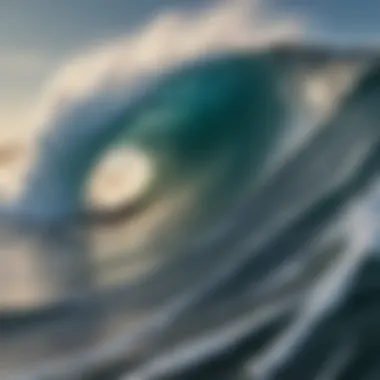
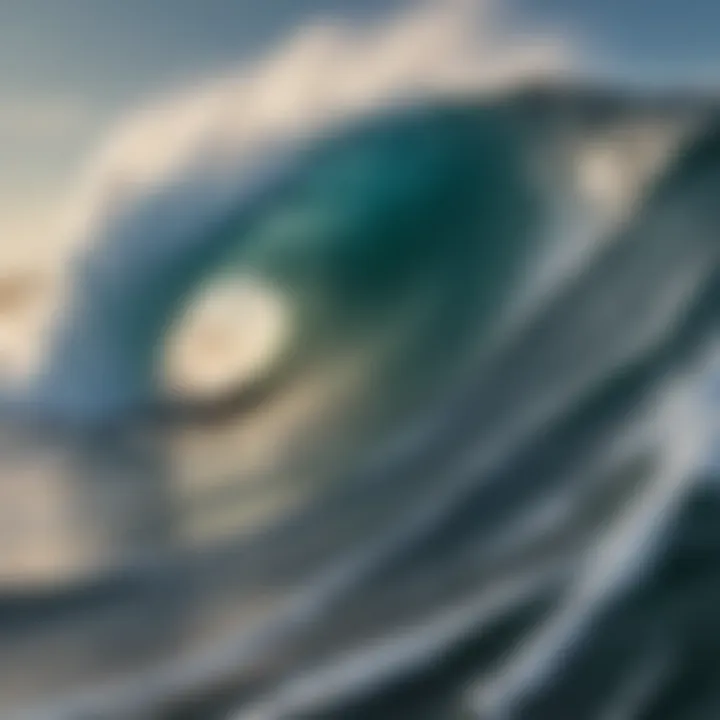
Understanding the environmental factors behind the formation of 100-foot waves provides crucial insight into their unpredictability and grandeur. These massive waves don’t just capriciously emerge; they are the result of intricate interactions between various elements such as ocean floor topography, climatic conditions, and seasonal patterns. Grasping these concepts not only benefits surfers and adventurers but also fosters a deeper respect for the ocean’s might.
Ocean Floor Topography
The ocean floor is like a hidden architect shaping wave formation. When we talk about ocean floor topography, we refer to the complex landscape beneath the waves. Think of underwater mountains, plateaus, and valleys. Each of these features influences how waves propagate and gain energy.
When a wave travels over a steep ascent in the seafloor, it can sharpen and rise unexpectedly. This can lead to the creation of powerful waves, often seen in places like Teahupo'o. Conversely, a gently sloping sea bed may allow waves to dissipate energy, leading to less dramatic wave patterns.
- Submarine Canyons: These canyons can funnel energy and produce waves that break with incredible intensity.
- Continental Shelves: Where the ocean meets land, this area affects how waves form and break as they approach the shore.
For surfers, knowing the topography of a location can be a make-or-break factor in deciding whether to ride a wave or play it safe.
Climatic Conditions
Climatic conditions play a vital role in the behavior of the ocean and thus in the wave patterns that surfers encounter. The interactions between air temperature, pressure, sea surface temperature, and wind patterns can drastically influence wave size and force. When strong winds blow over a long distance — known as fetch — they create large waves.
- Storm Systems: Intense storms can generate swells that travel thousands of miles. The infamous storm systems in the North Atlantic, for example, contribute significantly to wave formation along the east coast of North America.
- El Niño and La Niña Phenomena: These conditions can shift currents and weather patterns, drastically changing wave behavior and size in certain regions.
The relationship between climatic conditions and wave dynamics suggests that surfers must not only be skilled in catching waves but also knowledgeable about weather forecasts.
Seasonal Patterns
It's common knowledge that the seasons influence many activities, but the ocean has its own rhythm. Seasonal patterns can dictate when and where the largest waves tend to form. These fluctuations are driven mainly by changes in weather conditions and ocean currents.
- Winter Swell: In locations like Hawaii and California, winter tends to bring larger swells due to powerful storms in the North Pacific. Surfers eagerly anticipate this time, as it often produces some of the most formidable waves.
- Summer Patterns: In contrast, summer can yield smaller, more manageable waves in many areas, aligning more with recreational surfing than the thrill-seeking rides of winter.
As adventurers prepare for their excursions, recognizing these seasonal patterns can guide them in planning their surf trips effectively.
The immense force of 100-foot waves demands that surfers respect their unpredictable nature built by various environmental factors, each interconnected and influential in shaping the incredible beauty of the ocean.
Surfing and the Challenge of Giant Waves
Surfing has long been an exciting pursuit, merging skill, thrill, and sometimes a hint of danger. Riding giant waves, particularly those reaching 100 feet, transforms this sport into an extreme test of both physical prowess and mental courage. The essence of this experience goes beyond mere recreation; it encapsulates a deep respect for nature's raw power and beauty.
The challenge of surfing these monstrous waves attracts dedicated surfers and adventurers alike. Surfers often describe the experience of catching a giant wave as something akin to transcending reality—a moment where they are not just riding the wave but becoming one with it. The importance of understanding what it takes to surf such formidable giants cannot be overstated, as these waves require meticulous preparation and a keen awareness of personal limits.
Preparing to Ride 100-Foot Waves
Gear and Equipment
When it comes to surfing 100-foot waves, the right gear and equipment play an invaluable role. Modern surfboards for giant waves, often referred to as “gun” boards, are specially designed to handle the unique forces encountered at such heights. The crucial features of these boards include increased length and width, which provide the stability needed for maneuvering through powerful swells. Moreover, many of these boards come with a softer nose to help them navigate effectively through heavy water.
A board that successfully keeps a surfer above the turbulent sea can significantly reduce the risk of wipeouts. Additionally, safety gear like impact vests and leash straps offers a protective layer against painful falls or accidents. Still, the choice of equipment often comes down to personal preference, and finding the right balance between performance and safety remains essential.
Physical Conditioning
Physical conditioning is a cornerstone to riding giant waves. Surfers must undergo rigorous training regimes to build the necessary strength and endurance. This training typically combines cardiovascular exercises, resistance training, and flexibility workouts. A well-rounded fitness approach not only prepares surfers for the physical toll of riding massive waves but also enhances their balance and coordination.
The unique demand of giant wave surfing means surfers need a level of fitness that can keep up with the merciless ocean. However, conditioning should not solely focus on raw strength; it’s critical to include elements that nurture mental fortitude. The fusion of physical health and mental resilience proves to be an ace up any surfer’s sleeve.
Mental Preparation
Mental preparation is often overlooked but is equally vital when it comes to tackling giant waves. Developing a strong mental game can help surfers confront fear, anxiety, and uncertainty. Visualization techniques, where surfers mentally rehearse their rides, can be particularly useful. This approach fosters confidence as the surfer imagines themselves gliding through the waves without hiccup.
Moreover, mindfulness practices can aid in staying focused, especially in the tumult of the ocean. Surfers must learn to manage adrenaline spikes and remain composed, no matter the challenges presented by the waves. Acclimatization to the potential dangers of surfing giant waves creates a resilient mindset, which is just as crucial as physical readiness.
Risks and Safety Measures
Surfing 100-foot waves is not without its risks. The impact of a fall can be devastating. Heavy water can lead to significant injuries, from concussions to broken bones. Hence, safety measures are paramount. It’s essential to always surf with a buddy or team, ensuring that help is readily available in case of an emergency. Wearing a flotation vest can enhance buoyancy, ensuring that surfers stay above water during tough wipeouts.
Additionally, knowledge of the ocean and its behaviors is vital. Awareness of local conditions can provide insights into when it’s safe to surf and when it's better to stay ashore. Understanding the causes behind wave patterns can also lead to making informed decisions.
“The ocean is unpredictable, but that’s what makes it beautiful. Respect it, and it will grant you experiences you’ll never forget.”
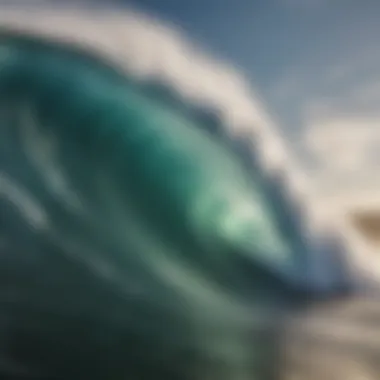
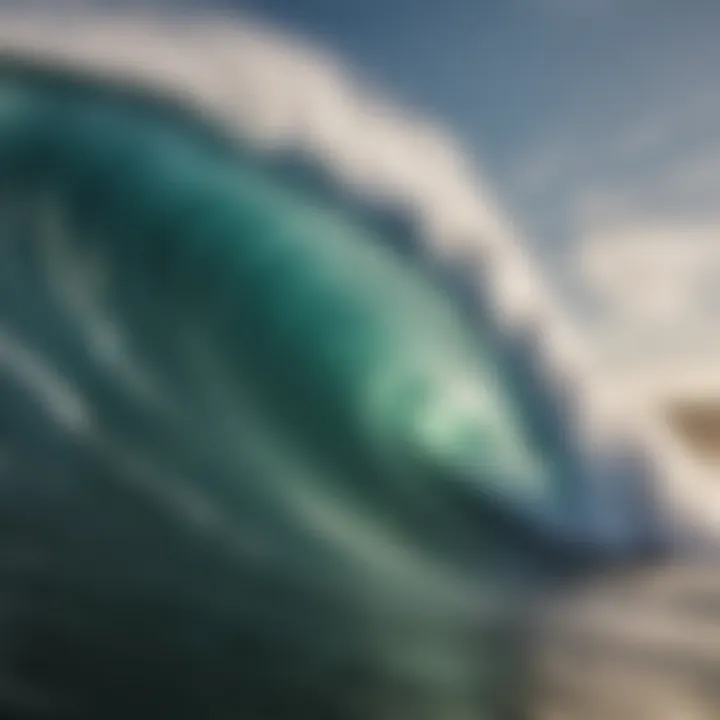
By grasping the nuances of surfing 100-foot waves—from the right gear to mental conditioning and taking appropriate safety precautions—surfing enthusiasts can unlock a world of possibilities while respecting the immense power of the ocean.
Cultural Impact of Giant Waves
Giant waves, particularly those reaching 100 feet, hold a significant cultural weight in the surfing realm and beyond. They symbolize not just the raw power of nature, but also a sense of identity for those who are deeply entrenched in the coastal cultures. These waves inspire awe, respect, and often, idolization, affecting how communities perceive and engage with the ocean itself. The cultural impact of such waves resonates through various layers—manifesting in art, media, community events, and personal narratives of surfers who brave the colossal waters.
Surfing Community and Identity
For many, the surfing community is a tribe, bound together by a shared passion for riding waves. The giants among those waves—the 100-footers—distinguish the elite surfers from the occasional riders. This distinction fosters a unique identity, where the daring undertakings of catching massive waves become a rite of passage. It’s not just about conquering the ocean; it’s a journey into self-discovery, testing personal limits and embracing risk. Surf culture venerates those who have had the courage to ride the biggest waves, creating legends that are celebrated within the community.
- Heroic Figure: Surfers who take on 100-foot waves often become icons, celebrated in surf documentaries and local lore. Their feats serve as motivation for upcoming surfers.
- Tight-knit Community: Events centered around giant waves promote camaraderie. Whether it’s local competitions or global surf festivals, they foster connections among diverse surfers.
- Tradition and Ritual: Surfing big waves is often accompanied by rituals, such as chants or ceremonies, that symbolize respect for the ocean and its unpredictability.
The identity forged within this community extends far beyond the sport; it's about a lifestyle that embraces adventure, respect for nature, and a deep sense of belonging.
Media Portrayal and Public Perception
The media plays a pivotal role in shaping how giant waves are perceived. Documentaries, social media, and news reports bring the towering waves into the limelight, often dramatizing the extreme conditions and the surfers who tackle them. Through this portrayal, the public gains a glimpse into the thrill and danger involved. However, it is a double-edged sword; while this visibility elevates the excitement around surfing, it also glosses over the risks and realities faced by surfers.
- Glorifying the Experience: Many documentaries romanticize the surge of adrenaline as surfers take on big waves, often showcasing them as larger-than-life heroes.
- Public Fascination: This spectacle draws in spectators—both on and off the beach—who may not understand the sheer force of these waves. They see the beauty but may neglect the peril.
- Influence of Social Media: Platforms like Instagram have transformed the way giant waves are shared. The visuals of surfers riding majestically tall waves fuel fascination, increasing interest in surfing culture by the day.
However, some critics have raised concerns about the potential glorification leading to reckless behavior among amateur surfers. The challenge remains: balancing the thrill and safety while respecting the breathtaking beauty that these giant waves present.
"Giant waves are more than just challenges—they are powerful forces that shape not only the ocean but also the hearts and minds of those who seek to ride them."
The cultural impact of giant waves thus creates a rich tapestry of narratives that connect individuals to their ocean environments, fostering community, identity, and a reverence for the majestic, unpredictable forces of nature.
The Future of 100-Foot Waves
The topic of 100-foot waves carries an immense significance, resonating deeply with both the surfing community and coastal scientists. As the effects of climate change ripple through oceanic patterns, the potential shift in wave characteristics could reshape our understanding of surfing and wave forecasting. Addressing the trajectory of these waves involves a multilayered approach; it’s not merely about the waves themselves but also about the intricate relationship between climate, technology, and cultural impact. By expanding our viewpoint, we gain insights into the future adaptability of surfers, coastal dwellers, and even policymakers.
Climate Change and Wave Patterns
Climate change has stirred quite a bit of conversation in scientific circles lately, and rightly so. The rising global temperatures aren’t just affecting weather; they're altering the very fabric of oceanic ecosystems. One aspect worth noting is how shifts in temperature can change the wind patterns, which are crucial for wave formation. Warmer air can lead to more extreme weather systems, resulting in increased storm activity. And we know that storms play a vital role in generating large waves.
Consider the following impacts of climate change on wave patterns:
- Increased Frequency of Storms: Weather systems are becoming more volatile, leading to stronger and more frequent storms creating the conditions for giant waves.
- Changing Ocean Currents: As sea levels rise and polar ice melts, the dynamics of ocean currents shift. These currents are pivotal in determining wave height and behavior, especially at coastal points.
- Temperature Variability: Swings in sea temperature may contribute to fluctuating wave conditions, potentially leading to more frequent occurrences of extreme waves.
These factors paint a rather dramatic picture. If you think back a few decades, there weren't many occurrences of 100-foot waves; today, they are nearly becoming a more common sight. This precarious transformation of wave dynamics raises questions about the preparedness of surfing communities and coastal infrastructures.
Advancements in Wave Forecasting Technology
As the wild world of science progresses, so too do the tools to understand it. The latest efforts in wave forecasting technology promise not only to enhance the safety of surfers but also allow for a better grasp of environmental changes affecting ocean waves.
New advancements include:
- High-Resolution Ocean Models: With the advent of sophisticated ocean modeling, scientists can now simulate various ocean conditions and predict the occurrence of massive waves with higher accuracy.
- Satellite Data: Satellites provide real-time data that help track wave development patterns across vast ocean spaces. This is instrumental in understanding how varying atmospheric conditions lead to wave formation.
- Machine Learning Algorithms: Software that analyzes historical wave data can identify patterns and offer forecasts that account for sea temperature changes and atmospheric conditions.
These technologies offer surfers an edge, enabling them to plan better and stay safer while braving the elements. But more importantly, they can inform policy decisions, guiding how we manage coastal communities and vitality in the face of nature’s might.
"The ocean is a formidable beast; understanding its rhythms and moods is key to coexisting with its power."
As we look to the horizon, it becomes evident that the future of 100-foot waves will be shaped by our responses to climate change and the innovations in technology that allow us to better predict their occurrence, making this a thrilling and vital area for ongoing research and exploration.
Finale: Respecting Nature’s Power
The phenomenon of 100-foot waves is a formidable display of nature's might, a reminder of the forces that govern our oceans. This article has journeyed through various facets of these colossal waves, revealing a layered understanding of their formation and impact.
When contemplating the grandeur of these waves, it's imperative for surfers, coastal communities, and adventurers alike to acknowledge the inherent risks intertwined with their beauty. Understanding how waves form, the climatic conditions that give rise to them, and the geographical factors involved can greatly enhance one's ability to approach these situations with both excitement and awareness.
Balancing Adventure and Caution
Riding a 100-foot wave is not just a thrilling endeavor; it's a complex calculation of courage and prudence. Surfers must weigh the allure of the challenge against the reality of the dangers. Here's what to consider in this balancing act:
- Preparation is Key: Surfers should equip themselves with the right gear, familiarize themselves with the wave’s specific characteristics, and keep tabs on weather forecasts and tide charts. Not all locations are equal; each spot has its own vibe and unique resolutions.
- Respect the Ocean: The ocean is unpredictable. What seems like a gentle swell can transform into a treacherous monster in a matter of moments. Staying aware and respectful of the ocean’s mood is essential for both safety and enjoyment.
- Know Your Limits: Understanding personal capabilities is crucial. Pushing past one's skill level not only endangers the individual but can also pose risks to others in the water. Sometimes, the bravest thing to do is to sit it out.
- Community Wisdom: Engaging with local surfing communities can provide insights into conditions and experiences that are not readily available in guidebooks. These shared stories and wisdom can aid in making informed decisions and navigating potential hazards.
“The sea is a harsh mistress, teaching respect through trials and tribulations.”
In essence, respecting nature's power boils down to knowledge and humility. As surfers look to master the art of riding these towering waves, they must forge a symbiotic relationship with the ocean, realizing it is both a playground and a potential peril. The beauty of riding a 100-foot wave lies not just in conquering it, but in appreciating the sheer force of nature that creates such opportunities in the first place. By embracing this duality of adventure and caution, one can truly experience the majesty of the ocean while also safely engaging with its might.













